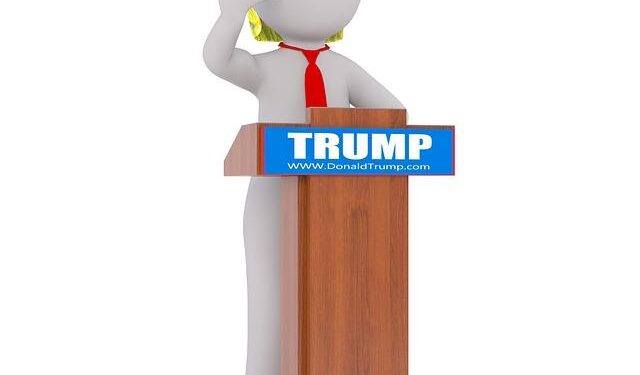In recent developments surrounding the political landscape of the United States, the ongoing updates on former President Donald Trump’s activities and the implications of his policies remain a focal point for analysts and citizens alike. The recent layoffs announced by the Department of Health and Human Services (HHS) bring into sharp focus the competing priorities of Trump and Robert F. Kennedy Jr. (RFK Jr.), particularly in the realm of public health and governance. This article delves into the nuances of these layoffs, examining how they reflect the broader strategic directions of both political figures, the potential impact on public health initiatives, and the responses from various stakeholders. As the nation anticipates the upcoming elections, understanding these dynamics becomes increasingly important in the context of healthcare policy and its implications for the American populace.
Trumps Strategic Focus on Health and Human Services Amidst Layoffs
In a bold move that highlights his strategic priorities, Trump is directing attention toward the Department of Health and Human Services (HHS) amidst recent layoffs affecting several key personnel. This focus reflects a dual aim: to streamline operations while asserting his vision for a government that prioritizes effective health policies. As he addresses these transitions, the administration is looking to reinforce its commitment to essential health services, even as it navigates the complexities brought about by workforce reductions. Key areas of focus include:
- Enhancing public health initiatives: Ensuring that critical health programs remain funded and operational.
- Streamlining resources: Allocating funds toward initiatives that yield the greatest impact on public health.
- Prioritizing mental health services: Addressing the rising concerns surrounding mental health care accessibility.
Furthermore, the layoffs have catalyzed discussions around fiscal responsibility and the balancing act of budget cuts while still safeguarding vital health infrastructure. Advocates argue that maintaining robust support for HHS is crucial not only for public health but also for the broader economy. In this context, the administration’s planned shifts can be illustrated as follows:
| Focus Area | Action Plan | Expected Outcome |
|---|---|---|
| Public Health Funding | Reallocation of resources | Improved service delivery |
| Workforce Optimization | Reduction and reassignment of roles | Increased efficiency |
| Mental Health Initiatives | Expansion of programs | Better access to services |

Impact of HHS Layoffs on Public Health Initiatives
The recent layoffs at the Department of Health and Human Services (HHS) have raised significant concerns regarding their potential repercussions on public health initiatives across the nation. As various programs face funding cuts and staff reductions, critical areas are likely to experience setbacks. The following aspects illustrate the anticipated impacts:
- Reduced Workforce: A smaller team could hinder the department’s ability to effectively manage and implement essential health programs.
- Delayed Projects: Ongoing initiatives related to disease prevention, maternal health, and substance abuse may face delays, affecting timely intervention.
- Funding Challenges: Layoffs may lead to reevaluation of budget allocations, leaving vital public health projects under-financed.
In examining the broader implications, it becomes clear that these workforce reductions may disproportionately affect vulnerable populations who rely on government-supported health services. A survey of various public health programs highlights which areas could be most at risk:
| Public Health Program | Current Status | Potential Impact |
|---|---|---|
| Maternal Health Initiatives | Operational | Increased maternal mortality rates |
| Vaccination Campaigns | In Progress | Lower vaccination uptake |
| Substance Abuse Programs | Threatened | Rising addiction rates |

RFK Jr.’s Stance on Healthcare and its Alignment with Trump’s Agenda
Both Robert F. Kennedy Jr. and former President Donald Trump share a critical stance on the current healthcare system in America, albeit their approaches reveal distinct nuances. Kennedy emphasizes a need for reform that prioritizes public health and transparency within pharmaceutical industries. He advocates for reducing bureaucratic overhead, promoting holistic treatment options, and giving patients greater autonomy in their healthcare decisions. His vision underscores a shift away from profit-driven motives, aiming for a healthcare framework based more on preventative care and natural treatments that he believes would benefit the populace as a whole.
Conversely, Trump’s healthcare ideology leans towards deregulation, echoing his broader agenda of reducing governmental oversight. He champions policies that encourage market competition among healthcare providers, which he argues will lead to lower prices for consumers. Trump’s proposals have included the need for tax incentives and healthcare innovation, aligning with his overarching goals of economic growth and job creation. Yet, in both cases, there appears to be a shared focus on curbing what they view as the inefficiencies of existing systems, particularly in the wake of the recently announced HHS layoffs which could signify a shift toward their collective vision of a transformed healthcare landscape.

Analyzing the Political Ramifications of HHS Workforce Reductions
The recent reductions in the U.S. Department of Health and Human Services (HHS) workforce have sparked a considerable debate regarding their implications on national health policies and political alliances. Proponents of the cuts argue that streamlining the workforce can lead to a more efficient government, potentially aligning with conservative priorities of reducing federal spending and minimizing government intervention in healthcare. Conversely, critics view these layoffs as a dangerous undermining of public health initiatives, particularly as the nation grapples with ongoing challenges from diseases, health inequities, and emerging public health threats. This divergent perspective highlights the stark political divides shaping discussions about health policy in the U.S.
As political figures like Robert F. Kennedy Jr. and Donald Trump navigate these changes, their responses reveal their differing approaches to health and governance. Where Trump may emphasize fiscal conservation and business-like efficiencies, Kennedy often advocates for preserving public services that promote health equity. This contrast can attract various voter bases and influence public sentiment. Understanding the ramifications of these layoffs is crucial, as they may serve to bolster or undermine public trust in government efficacy, depending on how the shifting landscape is perceived by the electorate.
| Politician | View on HHS Layoffs | Potential Voter Impact |
|---|---|---|
| Donald Trump | Supports workforce reductions for efficiency | Appeals to fiscally conservative voters |
| Robert F. Kennedy Jr. | Opposes layoffs; advocates for public health | Engages those valuing health equity |

Recommendations for Future Health Policy and Workforce Stability
As the implications of recent layoffs within the Department of Health and Human Services (HHS) reverberate across the healthcare landscape, it is imperative that future health policies prioritize both workforce stability and resource allocation. Policymakers should consider implementing a framework that ensures the retention of skilled professionals while promoting a holistic approach to healthcare service delivery. Key strategies may include:
- Enhanced Job Security: Policies that offer long-term contracts and benefits may elevate job satisfaction and reduce turnover rates.
- Professional Development Opportunities: Investment in ongoing training can empower the workforce, resulting in improved care quality and organizational loyalty.
- Workforce Mental Health Initiatives: Addressing burnout through support programs can foster a more resilient healthcare workforce.
Additionally, collaboration between various stakeholders is essential for developing a comprehensive health policy that addresses socioeconomic factors impacting healthcare access. By fostering partnerships between governmental entities, community organizations, and private sectors, an inclusive model can emerge that benefits both patients and providers. Consider these collaborative avenues:
- Integrated Care Models: Promote partnerships that blend physical and mental health services to enhance patient outcomes.
- Community Health Initiatives: Support local programs that address health disparities and encourage preventive care practices.
- Data-Driven Decision Making: Utilize analytics to monitor workforce efficacy and patient care metrics to inform policy adjustments.
| Focus Area | Suggested Action |
|---|---|
| Workforce Retention | Increase benefits and job security |
| Professional Growth | Invest in training and development |
| Community Engagement | Foster local health initiatives |

The Role of Public Perception in Shaping Healthcare Priorities Under Trump
The intersection of public perception and healthcare priorities under the Trump administration demonstrates a significant shift in how policies are shaped and implemented. Polling data and public sentiment often influenced decisions made by the Department of Health and Human Services (HHS). When voters expressed concerns about specific healthcare issues, such as prescription drug prices or access to mental health services, these topics were prioritized in policy discussions. This responsiveness to public opinion was evident in campaign strategies that emphasized healthcare as a pivotal issue, particularly leading up to the 2020 election.
Moreover, the emphasis on public perception also led to a polarization of healthcare topics. Conversations around the Affordable Care Act, vaccination mandates, and COVID-19 responses became highly politicized, reflecting broader societal divisions. As individuals rallied around various health-related causes, the administration had to navigate these tensions. The table below highlights some key healthcare priorities influenced by public opinion during the Trump era:
| Healthcare Priority | Public Sentiment | Policy Response |
|---|---|---|
| Prescription Drug Prices | High concern among voters | Proposals for pricing transparency |
| Access to Mental Health Services | Increased awareness and support | Funding boosts and program expansions |
| COVID-19 Response | Divided perceptions | Mixed messaging and reactive policies |
To Wrap It Up
the recent layoffs at the Department of Health and Human Services (HHS) serve as a notable focal point in understanding the differing priorities of political figures like Robert F. Kennedy Jr. and former President Donald Trump. As both individuals navigate their respective political landscapes, the implications of these job cuts highlight the broader themes of health policy and governance that resonate with their supporters and critics alike. The evolving situation at HHS not only underscores the urgent need for thoughtful leadership in the health sector but also reflects the ongoing debates surrounding public health, employment, and the role of government in ensuring the welfare of its citizens. As developments continue to unfold, observers will be keenly watching how these priorities shape the political narratives leading up to upcoming elections.











Mississippi State Football Schedule Breakdown: Ranking Games From Easiest To Hardest – Sports Illustrated